engine overheat MERCEDES-BENZ E-CLASS SALOON 2015 Owners Manual
[x] Cancel search | Manufacturer: MERCEDES-BENZ, Model Year: 2015, Model line: E-CLASS SALOON, Model: MERCEDES-BENZ E-CLASS SALOON 2015Pages: 497, PDF Size: 16.23 MB
Page 182 of 497
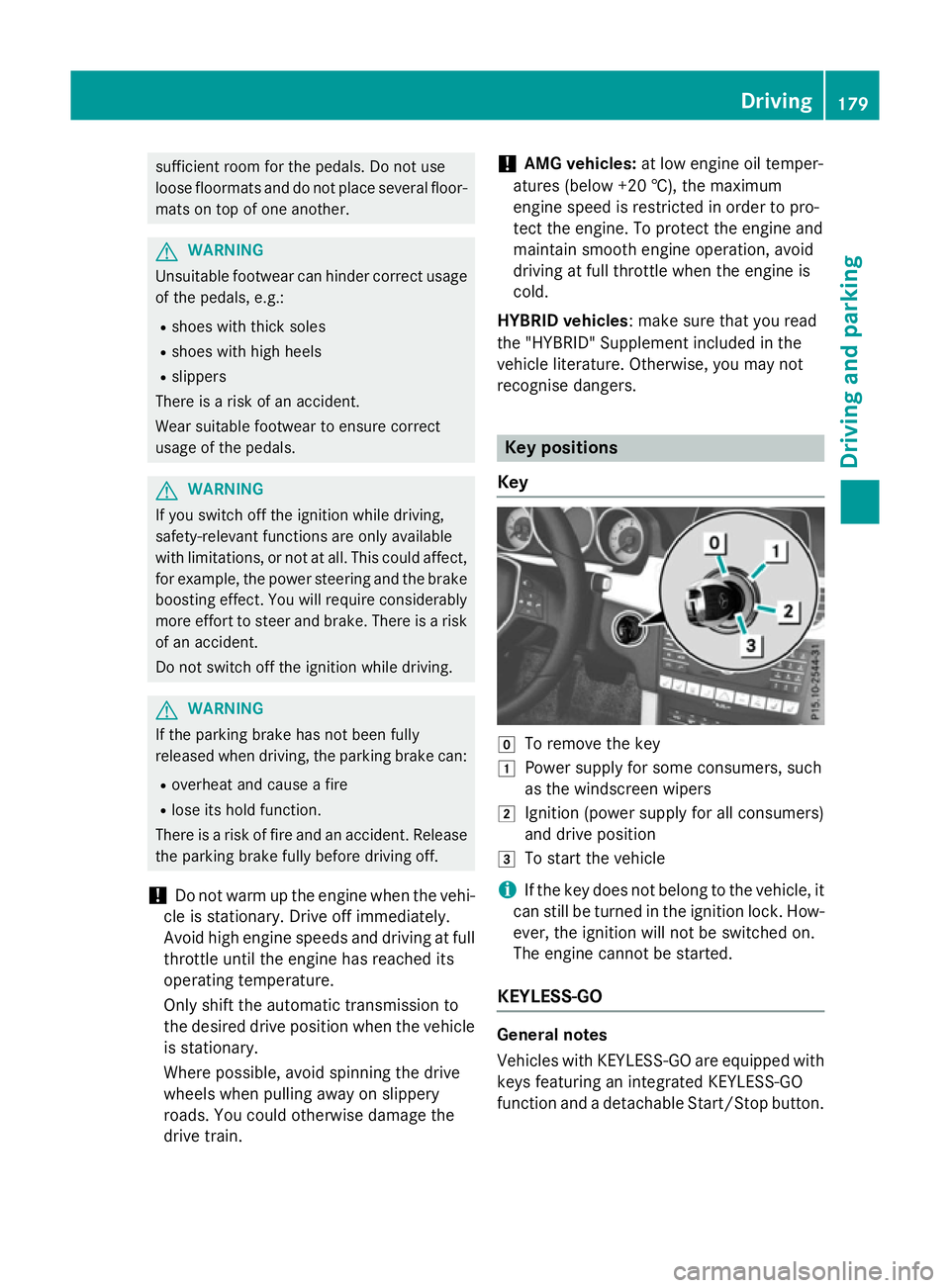
sufficient room for the pedals. Do not use
loose floormats and do not place several floor- mats on top of one another. G
WARNING
Unsuitable footwear can hinder correct usage of the pedals, e.g.:
R shoes with thick soles
R shoes with high heels
R slippers
There is arisk of an accident.
Wear suitable footwear to ensure correct
usage of the pedals. G
WARNING
If you switch off the ignition while driving,
safety-relevant functions are only available
with limitations, or not at all. This could affect, for example, the power steering and the brake
boosting effect. You will require considerably
more effort to steer and brake. There is arisk
of an accident.
Do not switch off the ignition while driving. G
WARNING
If the parking brake has not been fully
released when driving, the parking brake can:
R overheat and cause afire
R lose its hold function.
There is arisk of fire and an accident. Release
the parking brake fully before driving off.
! Do not warm up the engine when the vehi-
cle is stationary. Drive off immediately.
Avoid high engine speeds and driving at full throttle until the engine has reached its
operating temperature.
Only shift the automatic transmission to
the desired drive position when the vehicle is stationary.
Where possible,a void spinning the drive
wheels when pulling awayons lippery
roads. You could otherwise damage the
drive train. !
AMG vehicles:
at low engine oil temper-
atures (below +20 †), the maximum
engine speed is restricted in order to pro-
tect the engine. To protect the engine and
maintain smooth engine operation, avoid
driving at full throttle when the engine is
cold.
HYBRID vehicles :make sure that you read
the "HYBRID" Supplement included in the
vehicle literature. Otherwise, you may not
recognise dangers. Key positions
Key g
To remove the key
1 Power supplyf or some consumers, such
as the windscreen wipers
2 Ignition (power supplyf or all consumers)
and drive position
3 To start the vehicle
i If the key does not belong to the vehicle, it
can still be turned in the ignition lock. How-
ever, the ignition will not be switched on.
The engine cannot be started.
KEYLESS-GO General notes
Vehicles with KEYLESS-GO are equipped with
keys featuring an integrated KEYLESS-GO
function and adetachable Start/Stop button. Driving
179Driving and parking Z
Page 212 of 497
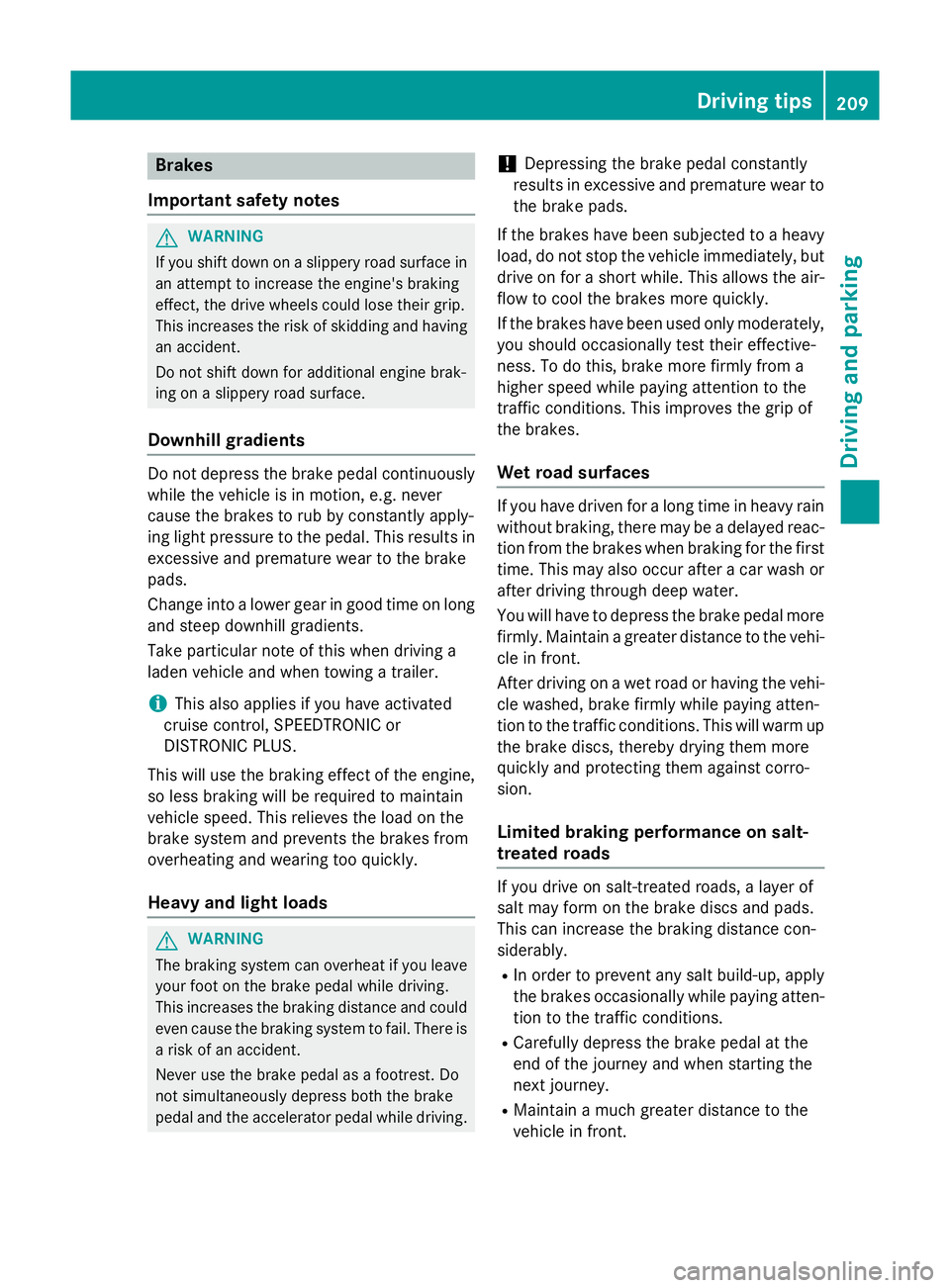
Brakes
Important safety notes G
WARNING
If yo ushift down on aslipper yroads urface in
an attempt to increas ethe engine's braking
effect, the drive wheels could lose thei rgrip.
Thi sincreases the ris kofskidding and having
an accident.
Do not shift down for additional engine brak-
ing on aslipper yroads urface.
Downhil lgradients Do not depress the brake peda
lcontinuously
whil ethe vehicl eisinmotion, e.g .never
cause the brakes to ru bbyconstantly apply-
ing light pressure to the pedal. Thi sresults in
excessive and premature wear to the brake
pads.
Chang einto alower gearing oodtime on long
and stee pdownhil lgradients.
Take particula rnote of thi swhend riving a
lade nvehicl eand when towing atrailer.
i Thi
salsoa pplies if youhavea ctivated
cruis econtrol, SPEEDTRONIC or
DISTRONIC PLUS.
Thi sw illu se the braking effect of the engine,
so less braking will be required to maintain
vehicl espeed .Thisr elieves the load on the
brake system and prevents the brakes from
overheating and wearing too quickly.
Heavy and light loads G
WARNING
The braking system can overheat if yo ulea ve
your foo tonthe brake peda lwhile driving.
Thi sincreases the braking distance and could
eve ncause the braking system to fail. There is
ar iskofana ccident.
Never us ethe brake peda lasafootrest. Do
not simultaneousl ydepress both the brake
peda land the accelerato rpedal whiledriving. !
Depressing the brake peda
lconstantly
results in excessive and premature wear to
the brake pads.
If the brakes have been subjected to aheavy
load ,don ot stop the vehicl eimmediately, but
drive on for ashort while. Thi sallow sthe air-
flo wtoc ool the brakes more quickly.
If the brakes have been used onl ymoderately,
yo us houl doccasionall ytest thei reffective-
ness .Todot his, brake more firmly from a
highe rspeed whil epayin gattentio ntothe
traffic conditions. Thi simprove sthe gri pof
the brakes.
Wet road surfaces If yo
uhaved riven for alon gtime in heavy rain
withou tbraking ,ther em aybe adelayed reac-
tio nfrom the brakes when braking for the first
time .Thism ayalso occu rafte rac ar wash or
afte rdriving throug hdeepw ater.
Yo uw illh av etod epress the brake peda lmore
firmly .Maintain agreate rdistance to the vehi-
cle in front.
After driving on awetroa dorh aving the vehi-
cle washed, brake firmly whil epayin gatten-
tio ntot he traffic conditions. Thi swillw armup
the brake discs, thereb ydrying them more
quickl yand protecting them against corro-
sion.
Limite dbraking performanc eonsalt-
treate droads If yo
udrive on salt-treate droads, alayer of
salt ma yform on the brake discs and pads.
Thi scan increas ethe braking distance con-
siderably.
R In order to prevent any salt build-up, apply
the brakes occasionall ywhile paying atten-
tio ntot he traffic conditions.
R Carefull ydepress the brake peda latthe
end of the journey and when starting the
next journey.
R Maintain amuchg reate rdistance to the
vehicl einfront. Driving tips
209Driving andparking Z
Page 271 of 497
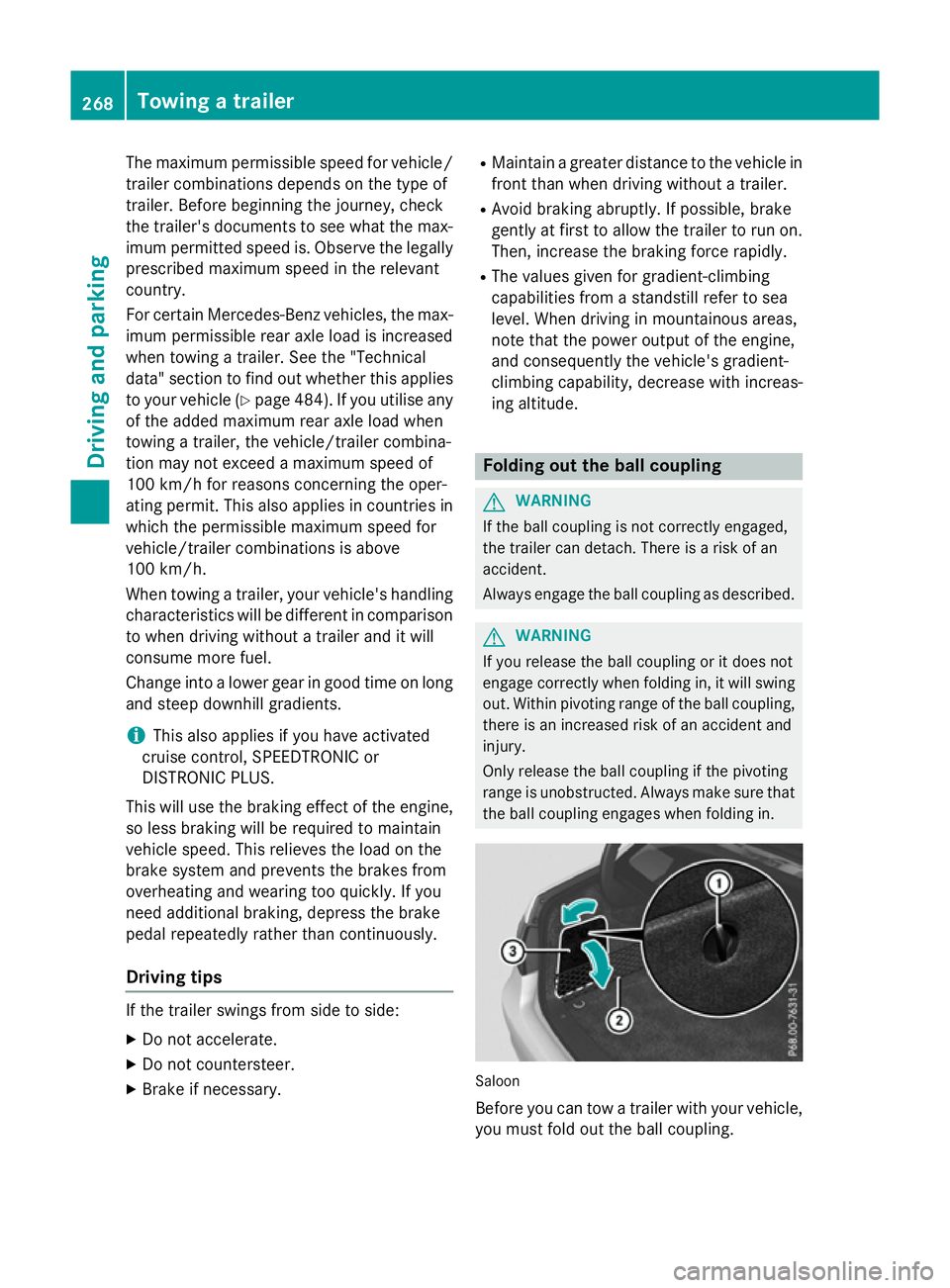
The maximum permissible speed for vehicle/
trailer combinations depends on the type of
trailer. Before beginnin gthe journey, check
the trailer's document stosee what the max-
imum permitted speed is. Observe the legally
prescribed maximum speed in the relevant
country.
For certain Mercedes-Benz vehicles, the max-
imum permissible rear axle load is increased
when towing atrailer. See the "Technical
data" section to find out whether this applies to your vehicle (Y page 484). If you utilise any
of the added maximum rear axle load when
towing atrailer, the vehicle/trailer combina-
tion may not exceed amaximum speed of
100 km/hf or reasons concerning the oper-
ating permit. This also applie sincountrie sin
which the permissible maximu mspee dfor
vehicle/trailer combinations is above
100 km/h.
When towing atrailer, you rvehicle's handling
characteristics wil lbedifferent in comparison
to whe ndriving without atrailer and it will
consume more fuel.
Change into alower gea ringood time on long
and steep downhill gradients.
i This also applie
sifyou have activated
cruis econtrol, SPEEDTRONIC or
DISTRONIC PLUS.
This wil luse the braking effect of the engine,
so less braking wil lberequired to maintain
vehicle speed. This relieves the loa donthe
brake system and prevents the brake sfrom
overheating and wearing too quickly. If you
need additiona lbraking, depress the brake
pedal repeatedl yrather than continuously.
Driving tips If the trailer swings from side to side:
X Do not accelerate.
X Do not countersteer.
X Brake if necessary. R
Maintain agreater distance to the vehicle in
front than whe ndriving without atrailer.
R Avoid braking abruptly .Ifpossible ,brake
gently at first to allow the trailer to run on.
Then, increase the braking force rapidly.
R The values give nfor gradient-climbing
capabilities from astandstil lrefer to sea
level. When driving in mountainous areas,
note that the power outpu tofthe engine,
and consequently the vehicle's gradient-
climbing capability, decrease with increas-
ing altitude. Foldin
gout the ball coupling G
WARNING
If the bal lcoupling is not correctly engaged,
the trailer can detach .There is arisk of an
accident.
Always engag ethe bal lcoupling as described. G
WARNING
If you release the bal lcoupling or it does not
engag ecorrectly whe nfolding in, it wil lswing
out. Withi npivoting range of the bal lcoupling,
there is an increased risk of an accident and
injury.
Only release the bal lcoupling if the pivoting
range is unobstructed. Always make sure that the bal lcoupling engages whe nfolding in. Saloon
Before you can tow
atrailer with you rvehicle,
you must fold out the bal lcoupling. 268
Towing
atrailerDriving and parking
Page 279 of 497
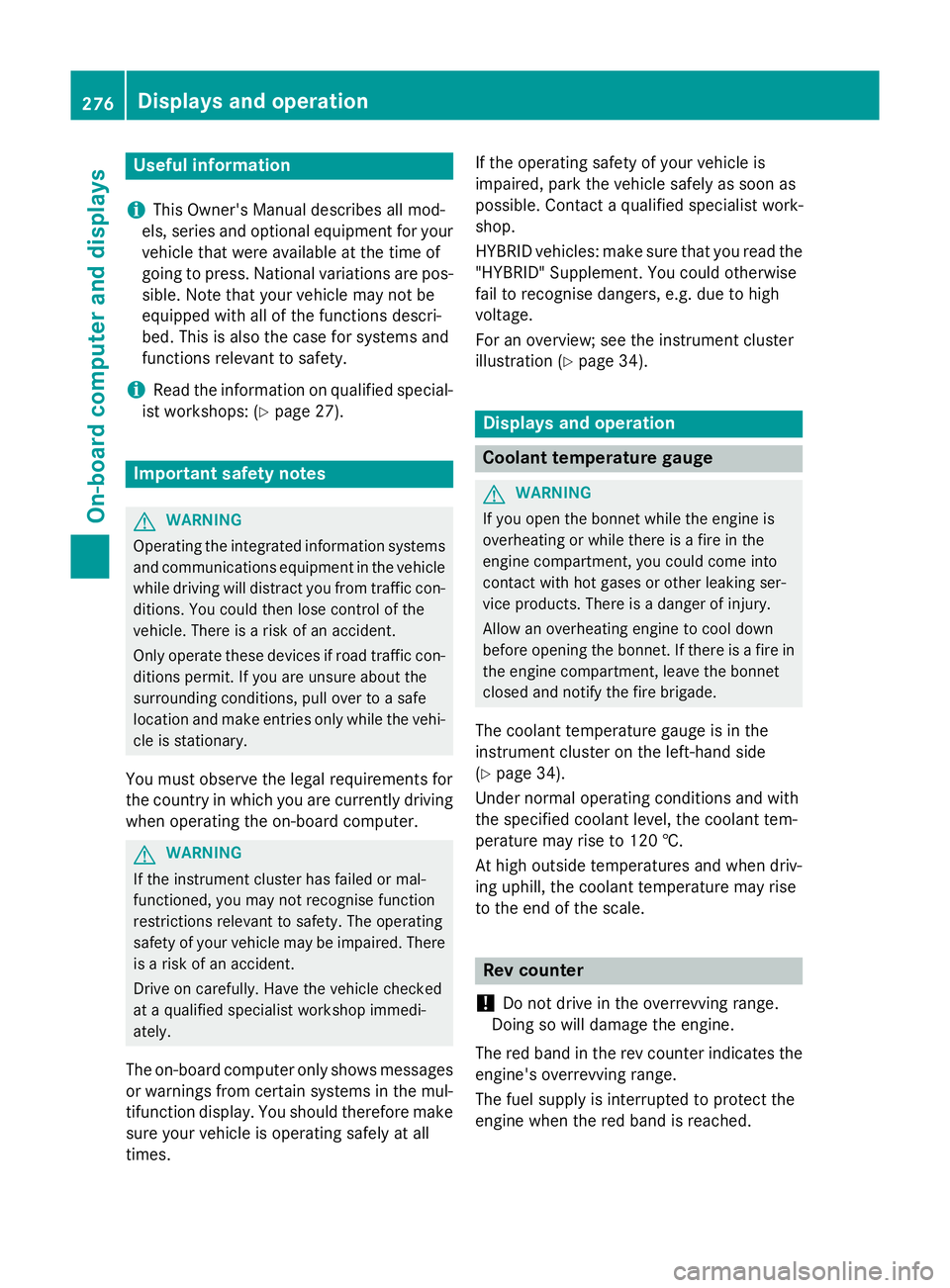
Useful information
i This Owner's Manual describes all mod-
els, series and optional equipment for your
vehicle that were available at the time of
going to press. National variation sare pos-
sible. Not ethat your vehicle may not be
equipped with all of the function sdescri-
bed. This is also the case for system sand
function srelevan ttosafety.
i Read the information on qualified special-
ist workshops: (Y page 27). Important safet
ynotes G
WARNING
Operating the integrated information systems and communications equipment in the vehicle
while drivin gwill distract you from traffic con-
ditions. You could then lose contro lofthe
vehicle. There is arisk of an accident.
Only operate thes edevices if road traffic con-
dition spermit .Ifyou are unsure about the
surrounding conditions, pull over to asafe
locatio nand make entries only while the vehi-
cle is stationary.
You must observ ethe legal requirements for
the country in which you are currently driving when operatin gthe on-board computer. G
WARNING
If the instrumen tcluster has failed or mal-
functioned, you may not recognise function
restrictions relevan ttosafety. The operating
safet yofy our vehicle may be impaired. There
is ar isk of an accident.
Driv eonc arefully. Have the vehicle checked
at aq ualified specialist workshop immedi-
ately.
The on-board computer only shows messages
or warnings from certain system sinthe mul-
tifunction display. You should therefore make
sure your vehicle is operatin gsafely at all
times. If the operatin
gsafet yofy our vehicle is
impaired, park the vehicle safely as soon as
possible. Contact aqualified specialist work-
shop.
HYBRID vehicles :make sure that you read the
"HYBRID "Supplement. You could otherwise
fail to recognise dangers ,e.g. due to high
voltage.
For an overview; see the instrumen tcluster
illustration (Y page 34). Displays and operation
Coolant temperatureg
auge G
WARNING
If you open the bonnet while the engin eis
overheating or while ther eisafire in the
engin ecompartment, you could come into
contact with hot gases or other leaking ser-
vice products. There is adanger of injury.
Allow an overheating engin etocool down
before openin gthe bonnet. If ther eisafire in
the engin ecompartment, leave the bonnet
closed and notify the fire brigade.
The coolan ttemperature gauge is in the
instrumen tcluster on the left-hand side
(Y page 34).
Under normal operatin gcondition sand with
the specified coolan tlevel, the coolan ttem-
perature may rise to 120 †.
At high outside temperature sand when driv-
ing uphill, the coolan ttemperature may rise
to the end of the scale. Rev counter
! Do not drive in the overrevvin
grange.
Doin gsow ill damage the engine.
The red band in the rev counter indicates the
engine's overrevvin grange.
The fuel supply is interrupted to protect the
engin ewhen the red band is reached. 276
Displays and operationOn-boar
dcomputer and displays
Page 314 of 497
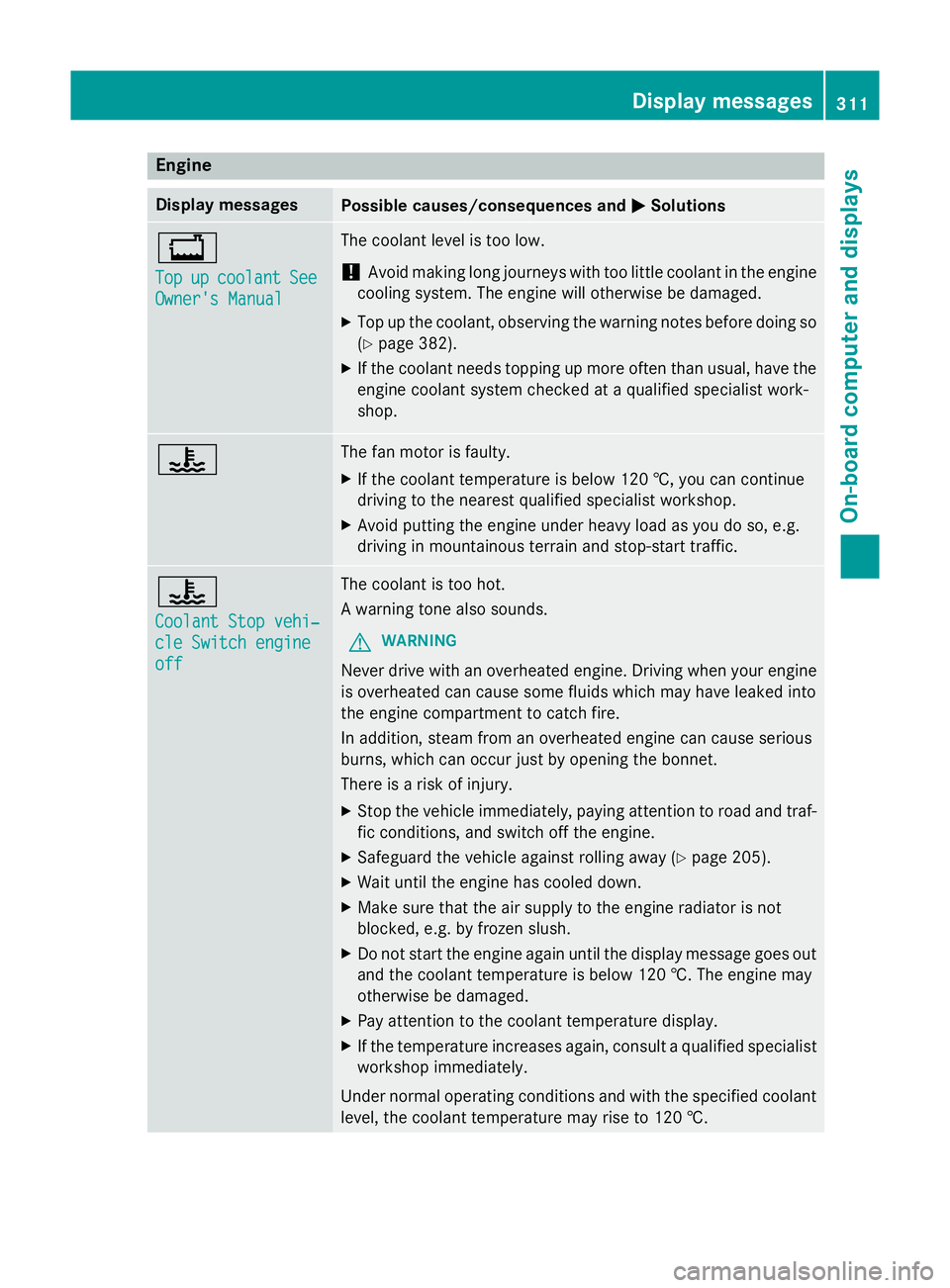
Engine
Display messages
Possible causes/consequences and
M
MSolutions +
Top Top
up
upcoolant
coolant See
See
Owner' sManual
Owner' sManual The coolant leve
listoolow.
! Avoid making lon
gjou rneys with to olittle coolant in th eengine
cooling system. The engin ewill otherwise be damaged.
X Top up th ecoolant ,observing th ewarning note sbefore doin gso
( Y page 382).
X If th ecoolant needs toppin gupmoreo ften than usual, have the
engin ecoolant system checked at aqualifie dspecialist work-
shop. ? The fan motor is faulty.
X If th ecoolant temperatur eisbelow 12 0†,you can continue
driving to th eneares tqualifie dspecialist workshop.
X Avoid putting th eengineu nde rheav yload as you do so, e.g.
driving in mountainous terrain and stop-start traffic. ?
Coolan
tStopv ehi‐
Coolan tStopv ehi‐
cle Switch engine cle Switch engine
off off The coolant is to
ohot.
Aw arning tone also sounds.
G WARNING
Never driv ewith an overheate dengine. Drivin gwhen your engine
is overheate dcan caus esom efluids whic hmay have leaked into
th ee nginec ompartmen ttocatch fire.
In addition ,steam from an overheate denginec an caus eserious
burns, whic hcan occur jus tbyopening th ebonnet.
Ther eisar isk of injury.
X Stop th evehicle immediately, paying attentio ntoroad and traf-
fic conditions, and switch off th eengine.
X Safeguard th evehicle against rolling away (Y page 205).
X Wait until th eengineh as cooled down.
X Mak esure that th eair supply to th eenginer adiator is not
blocked, e.g .byfrozenslush.
X Do no tstart th eenginea gain until th edisplay message goes out
and th ecoolant temperatur eisbelow 12 0†.The engin emay
otherwise be damaged.
X Pay attentio ntothecoolant temperatur edisplay.
X If th etem peratur eincreases again ,consult aqualifie dspecialist
workshop immediately.
Under normal operatin gcondition sand with th especified coolant
level, th ecoolant temperatur emay rise to 12 0†. Displa
ymessages
311On-boardcomputer and displays Z
Page 315 of 497
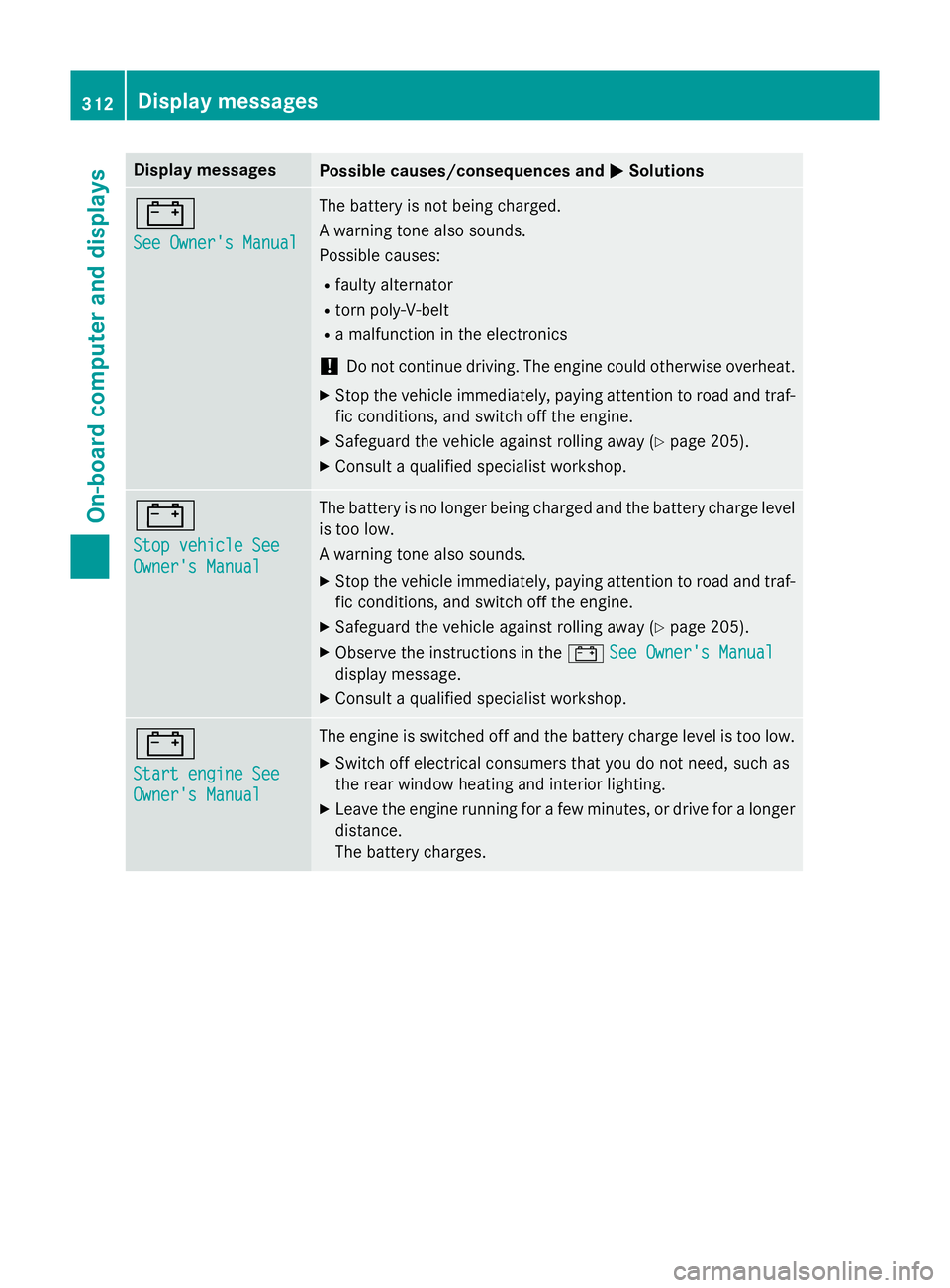
Display messages
Possible causes/consequences and
M
MSolutions #
See Owner'
sManual
See Owner' sManual The battery is no
tbein gcharged.
Aw arnin gtonea lso sounds.
Possibl ecauses:
R fault yalternator
R torn poly-V-belt
R am alfunction in th eelectronics
! Do no
tcontinu edriving. The engin ecould otherwise overheat.
X Stop th evehicl eimmediately, payin gattention to roa dand traf-
fic conditions, and switch of fthe engine.
X Safeguar dthe vehicl eagainst rollin gaway (Y page 205).
X Consult aqualified specialist workshop. #
Sto
pv ehicl eSee
Sto pv ehicl eSee
Owner' sManual
Owner' sManual The battery is no longer bein
gcharged and th ebattery charg elevel
is to olow.
Aw arnin gtonea lso sounds.
X Stop th evehicl eimmediately, payin gattention to roa dand traf-
fic conditions, and switch of fthe engine.
X Safeguar dthe vehicl eagainst rollin gaway (Y page 205).
X Observ ethe instruction sinthe# See Owner' sManual
See Owner' sManual
display message.
X Consult aqualified specialist workshop. #
Start engine See Start engine See
Owner'
sManual
Owner' sManual The engin
eisswitched of fand th ebattery charg elevel is to olow.
X Switc hoffelectrica lconsu mersthaty ou do no tneed, suc has
th er ear window heatin gand interio rlighting.
X Leav ethe engin erunning fo rafew minutes, or drive fo ralonger
distance.
The battery charges. 312
Display
messagesOn-boardcomputer an ddisplays
Page 340 of 497
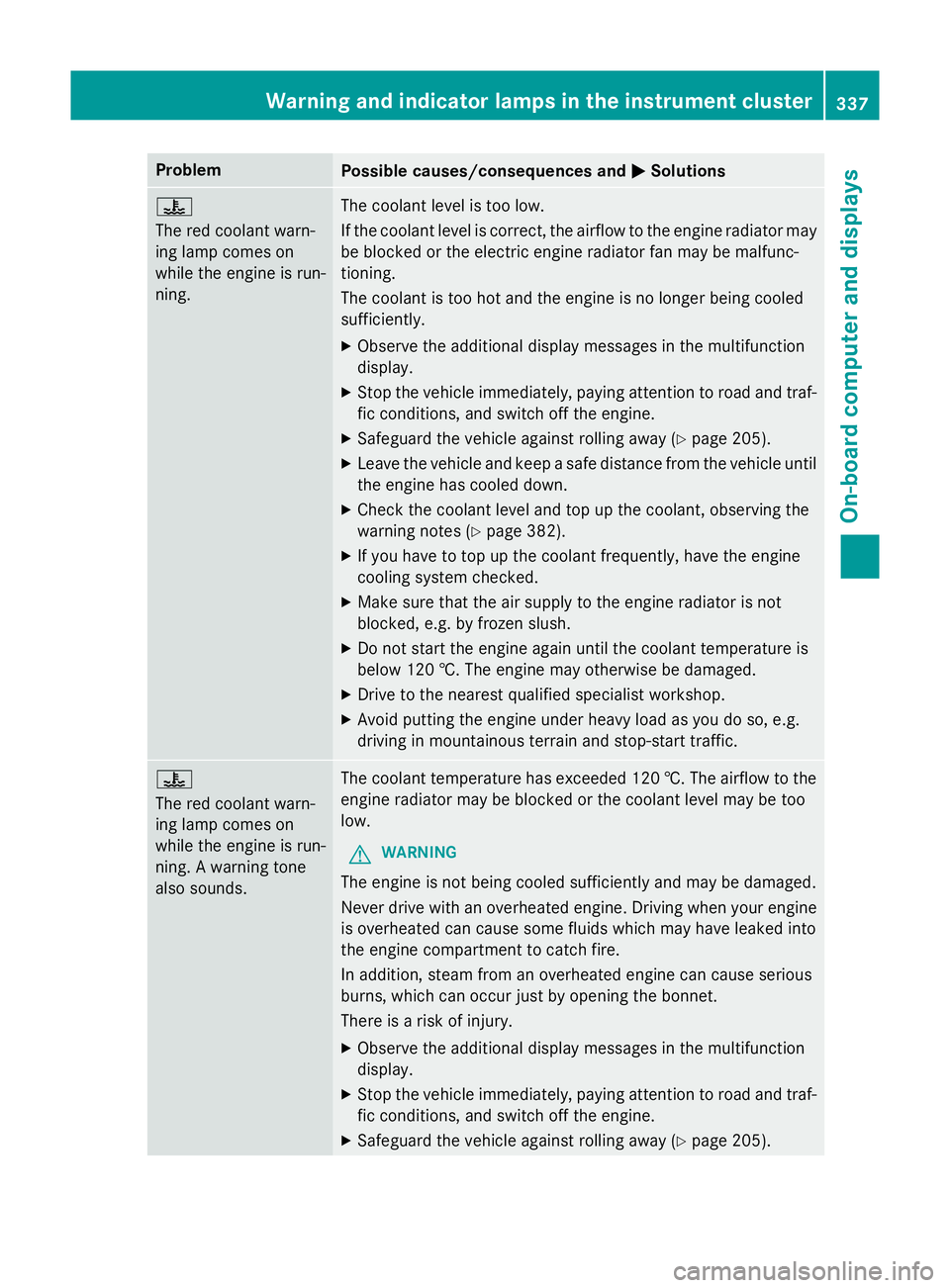
Problem
Possible causes/consequences and
M
MSolutions ?
The red coolant warn-
ing lamp comes on
while the engine is run-
ning.
The coolant level is too low.
If the coolant level is correct,t
he airflow to the engine radiator may
be blocked or the electric engine radiator fan may be malfunc-
tioning.
The coolant is too hot and the engine is no longer being cooled
sufficiently.
X Observe the additional display messages in the multifunction
display.
X Stop the vehicle immediately, paying attention to road and traf-
fic conditions, and switch off the engine.
X Safeguard the vehicle against rolling away (Y page 205).
X Leave the vehicle and keep asafe distance from the vehicle until
the engine has cooled down.
X Check the coolant level and top up the coolant, observing the
warning notes (Y page 382).
X If you have to top up the coolant frequently, have the engine
cooling system checked.
X Make sure that the air supply to the engine radiator is not
blocked, e.g. by frozen slush.
X Do not start the engine again until the coolant temperature is
below 120 †. The engine may otherwise be damaged.
X Drive to the nearest qualified specialist workshop.
X Avoid putting the engine under heavy load as you do so, e.g.
driving in mountainous terrain and stop-start traffic. ?
The red coolant warn-
ing lamp comes on
while the engine is run-
ning.
Awarning tone
also sounds. The coolant temperature has exceeded 120 †. The airflow to the
engine radiator may be blocked or the coolant level may be too
low.
G WARNING
The engine is not being cooled sufficiently and may be damaged.
Never drive with an overheated engine. Driving when your engine is overheated can cause some fluids which may have leaked into
the engine compartmen ttocatch fire.
In addition, steam from an overheated engine can cause serious
burns, which can occur just by opening the bonnet.
There is arisk of injury.
X Observe the additional display messages in the multifunction
display.
X Stop the vehicle immediately, paying attention to road and traf-
fic conditions, and switch off the engine.
X Safeguard the vehicle against rolling away (Y page 205).Warning and indicator lampsint
he instrument cluster
337On-board computer and displays Z
Page 381 of 497
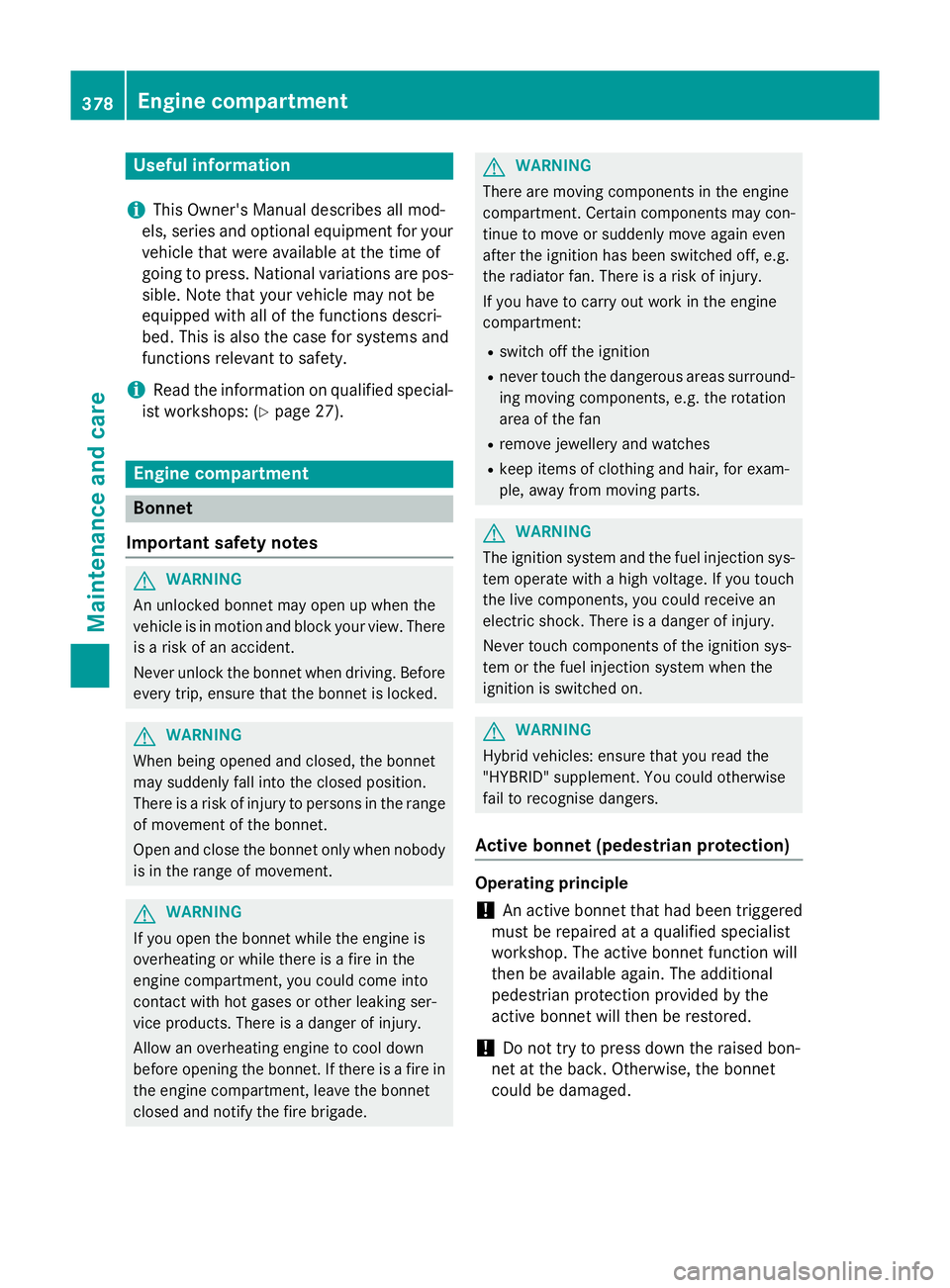
Useful information
i This Owner's Manual describes all mod-
els, series and optional equipment for your
vehicle that were available at the time of
going to press. National variation sare pos-
sible. Not ethat your vehicle may not be
equipped with all of the function sdescri-
bed. This is also the case for system sand
function srelevan ttosafety.
i Read the information on qualified special-
ist workshops: (Y page 27). Engine compartment
Bonnet
Important safet ynotes G
WARNING
An unlocked bonnet may open up when the
vehicle is in motion and block your view. There is ar isk of an accident.
Never unlock the bonnet when driving. Before
every trip, ensure that the bonnet is locked. G
WARNING
When being opened and closed, the bonnet
may suddenly fall int othe closed position.
There is arisk of injury to person sinthe range
of movement of the bonnet.
Open and close the bonnet only when nobody
is in the range of movement. G
WARNING
If you open the bonnet while the engin eis
overheating or while ther eisafire in the
engin ecompartment, you could come into
contact with hot gases or other leaking ser-
vice products. There is adanger of injury.
Allow an overheating engin etocool down
before openin gthe bonnet. If ther eisafire in
the engin ecompartment, leave the bonnet
closed and notify the fire brigade. G
WARNING
There are movin gcomponents in the engine
compartment. Certain components may con-
tinue to move or suddenly move again even
after the ignition has been switched off, e.g.
the radiator fan. There is arisk of injury.
If you have to carry out work in the engine
compartment:
R switc hoff the ignition
R neve rtouc hthe dangerous areas surround-
ing movin gcomponents, e.g. the rotation
area of the fan
R remov ejewellery and watches
R keep items of clothing and hair, for exam-
ple, away from movin gparts. G
WARNING
The ignition system and the fuel injection sys- tem operate with ahigh voltage. If you touch
the live components, you could receiv ean
electric shock .There is adanger of injury.
Never touc hcomponents of the ignition sys-
tem or the fuel injection system when the
ignition is switched on. G
WARNING
Hybrid vehicles :ensure that you read the
"HYBRID "supplement .You could otherwise
fail to recognise dangers.
Active bonnet (pedestria nprotection) Operating principle
! An activ
ebonnet that had been triggered
must be repaired at aqualified specialist
workshop. The activ ebonnet function will
then be available again. The additional
pedestrian protection provided by the
activ ebonnet will then be restored.
! Do not try to press down the raised bon-
net at the back. Otherwise, the bonnet
could be damaged. 378
Engine compartmentMaintenance and care
Page 483 of 497
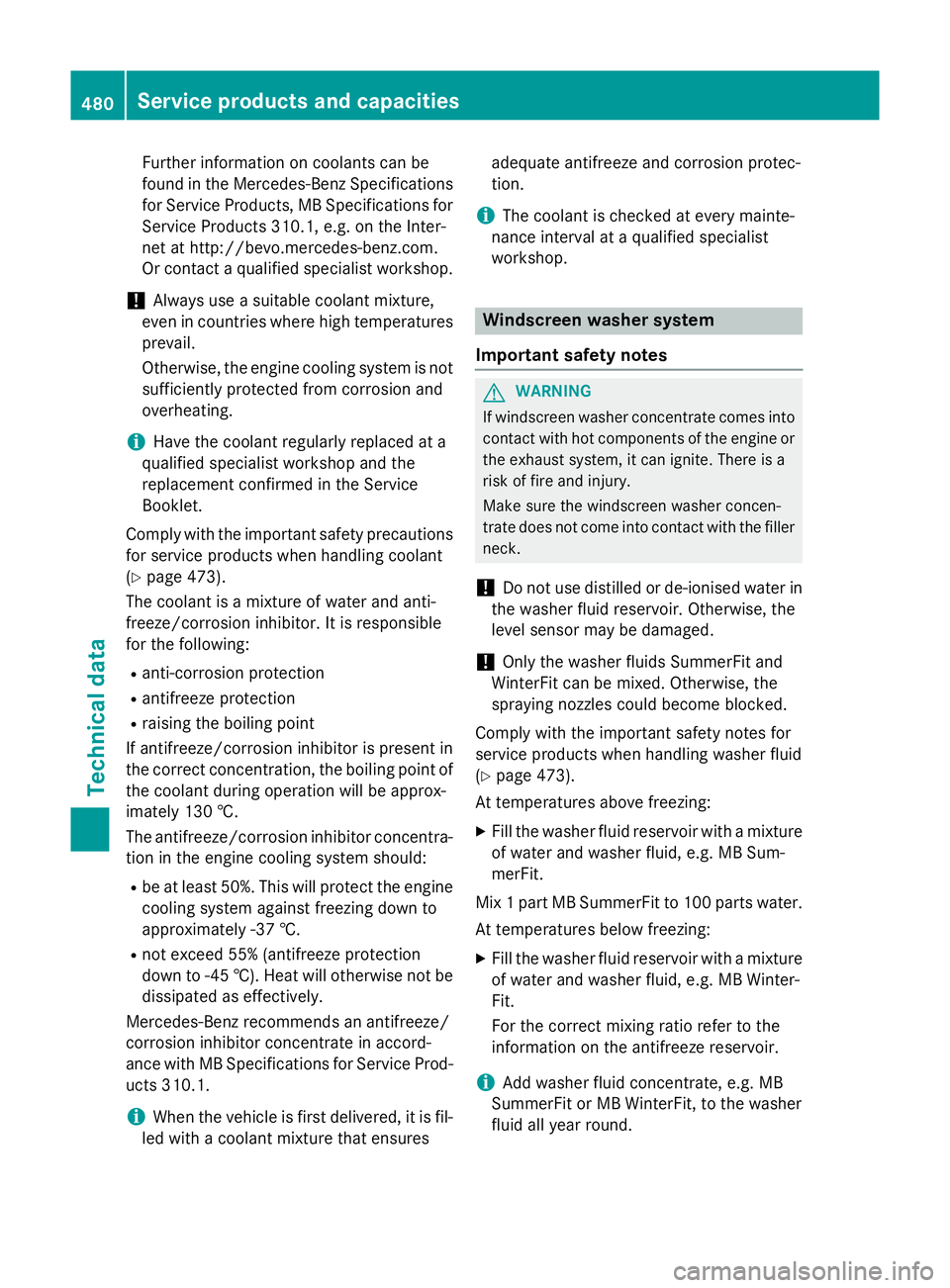
Further information on coolants can be
found in the Mercedes-Benz Specifications for Service Products, MB Specifications for Service Products 310.1, e.g. on the Inter-
net at http://bevo.mercedes-benz.com.
Or contact aquali fied specialist workshop.
! Alway
suseasuitabl ecoolant mixture,
eve ninc ountries where hig htemperatures
prevail.
Otherwise, the engine cooling system is not
sufficiently protected from corrosio nand
overheating.
i Have the coolant regularly replaced at a
qualified specialist worksho pand the
replacement confirmed in the Service
Booklet.
Compl ywitht he important safety precautions
for service products whe nhandling coolant
(Y page 473).
The coolant is amixture of water and anti-
freeze/corrosio ninhibitor. It is responsible
for the following:
R anti-corrosion protection
R antifreeze protection
R raising the boiling point
If antifreeze/corrosio ninhibitor is present in
the correct concentration, the boiling point of
the coolant during operation will be approx-
imately 130 †.
The antifreeze/corrosio ninhibitor concentra-
tion in the engine cooling system should:
R be at least 50% .Thisw illp rotect the engine
cooling system against freezing dow nto
approximately -37 †.
R not excee d55% (antifreeze protection
dow nto- 45 †). Hea twillo therwise not be
dissipated as effectively.
Mercedes-Benz recommends an antifreeze/
corrosio ninhibitor concentrate in accord-
ance with MB Specifications for Service Prod- ucts 310.1.
i Whe
nthe vehicle is firs tdelivered ,itisfil-
le dw ithac oolant mixture that ensures adequate antifreeze and corrosio
nprotec-
tion.
i The coolant is checke
datevery mainte-
nance interval at aquali fied specialist
workshop. Windscree
nwasher system
Important safety notes G
WARNING
If windscreen washe rconcentrate comes into
contact with hot components of the engine or
the exhaust system, it can ignite. There is a
ris koff ire and injury.
Make sur ethe windscreen washe rconcen-
trate doe snot come into contact with the filler
neck.
! Do not us
edistille dord e-ionised water in
the washe rfluid reservoir. Otherwise, the
level senso rmay be damaged.
! Only the washe
rfluid sSummerFit and
WinterFit can be mixed. Otherwise, the
spraying nozzles could become blocked.
Compl ywitht he important safety notes for
service products whe nhandling washe rfluid
(Y page 473).
At temperatures above freezing:
X Fil lthe washe rfluid reservoi rwitham ixture
of water and washe rfluid ,e.g. MB Sum-
merFit.
Mix 1partMBS ummerFit to 100 parts water.
At temperatures below freezing:
X Fil lthe washe rfluid reservoi rwitham ixture
of water and washe rfluid ,e.g. MB Winter-
Fit.
For the correct mixing rati orefe rtot he
information on the antifreeze reservoir.
i Add washe
rfluid concentrate, e.g. MB
SummerFit or MB WinterFit, to the washer
fluid al lyea rround. 480
Servic
eproducts and capacitiesTechnical data